Tom Phillips in Urumqi
Friday 9 October 2015 06.15 EDT
Friday 9 October 2015 06.15 EDT
Yellow signs swing from lampposts urging citizens to “hold high the great banner of national unity”. Red banners hang from bridges imploring drivers to “unswervingly promote long-term stability”.
“The Party’s great policy is the root of our great life!” shouts another one of hundreds of posters lining the motorway into the heart of the mountain-flanked northwestern city of Urumqi.
As Beijing celebrates the 60th birthday of China’s Xinjiang Uyghur Autonomous Region this month, Communist party officials have decked out the region’s cities and towns in a garish blaze of multi-coloured propaganda.
Taxi drivers have been ordered to place Chinese flags on their vehicles while roundabouts and street corners have been decorated with animal-shaped flower arrangements.
“Tremendous changes have taken place in Xinjiang over the past 60 years,”boasted a government white paper marking the anniversary. “Today, Xinjiang is standing at a new starting point for development … A brighter future beckons.”
The energetic government celebrations are part of a concerted push to depict the troubled region as a place of economic opportunity not ethnic riots.
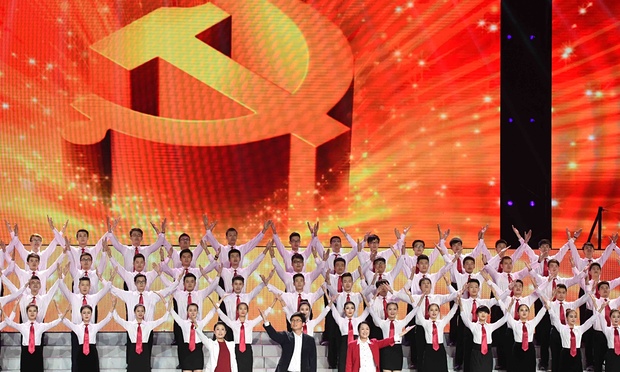
Performers attend the gala celebrating the 60th anniversary of the founding of Xinjiang Uygur Autonomous Region in Urumqi. Photograph: Gao Jie/Xinhua Press/Corbis
For decades Xinjiang, a vast region of snow-capped mountains and deserts, has been the setting for frictions and deadly explosions of violence between the native Muslim Uighur minority and a rising influx of Han Chinese migrants.
Now, Beijing – which recently lured British chancellor George Osborne to the resource-rich region – is fighting to promote a more dynamic image of Xinjiang, which president Xi Jinping has placed at the heart of an economic “pivot west” towards Central Asia.
“This is a big deal with a lot of time and effort being put into it,” James Leibold, a Xinjiang expert from La Trobe University in Melbourne, said of the festivities. “They need to demonstrate to a whole range of constituencies that Xinjiang is open for business and that Xinjiang is calm and normal.”
In fact, there is little normal about the backdrop to Xinjiang’s 60thanniversary, which comes amid growing ethnic tension and, many also suspect, bloodletting.
In the capital, Urumqi, primary schools are fenced off by yellow and black barricades – installed after a May 2014 bomb attack that was blamed on Uighur extremists and led Beijing to launch a crackdown dubbed the “people’s war” on terror.
Armoured vehicles, flanked by soldiers with automatic weapons, sit outside mosques, public squares and amusement parks, partly the consequence of deadly ethnic riots in 2009 that claimed about 200 lives.
Uighur neighbourhoods are patrolled by teams of black-clad police carrying riot shields and wooden clubs.
“If anything happens you just yell and people will come. We’ve had a lot of rehearsals,” said Li Juntao, a security officer at a children’s amusement park where Tweety Bird rides and a mushroom-shaped merry-go-round are guarded by an APC manned with rifle-toting soldiers.
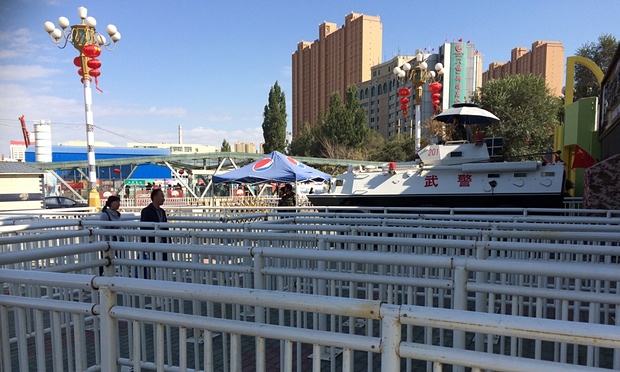
An armoured vehicle sits outside a children’s amusement park in Urumqi. Photograph: Tom Phillips for the Guardian
Li, a 46-year-old migrant from Henan province, insisted the security situation was under control, even if the government still felt it necessary to station heavily armed troops near children’s playgrounds.
“It’s quite safe here. As a matter of fact, the security in Xinjiang is quite good,” the father of two claimed.
China’s state-controlled press mirrors those claims, churning out story after story about Xinjiang’s rosy prospects to commemorate this month’s celebrations.
“Life in Xinjiang is getting better and better,” a recent headline in China’s official news agency Xinhua claimed, citing a French writer whom it said had recently visited.
A government report issued a barrage of positive statistics about the autonomous region’s bright outlook: in recent decades Xinjiang had built 175,000km of highway, 5,760km of railway track and 16 airports, it said. Half-a-million urban jobs were now being created each year.
Yet reports from Radio Free Asia (RFA), a Washington-based news service that produces some of the only reliable reporting on Xinjiang, suggest all is not well on China’s western frontier.
In the lead-up to this month’s festivities, RFA has reported on a coalmine massacre in Aksu in which at least 50 people died, a “knife and bomb attack” by a group of Uighurs on traffic police in which at least 18 people were killed, and the fatal shootings of at least eight Uighur men who had been deemed “suspicious” by police.
Nicholas Bequelin, an expert on the region who is Amnesty International’s regional director for East Asia, said, “There is a very serious ethnic problem in Xinjiang that is not being addressed but instead is being suppressed and concealed and is becoming more severe by the day.”
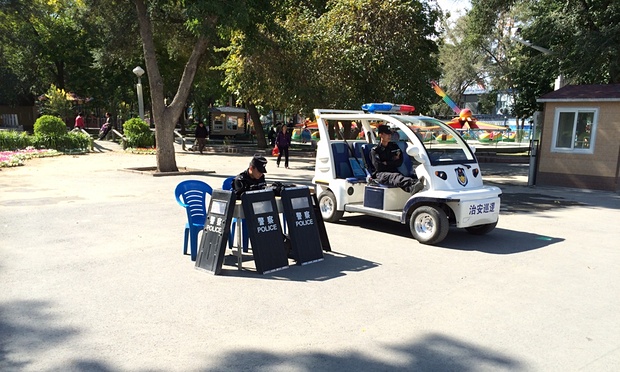
Police with riot shields guard a children’s amusement park in Urumqi. Photograph: Tom Phillips for the Guardian
Beijing blames much of the violence in Xinjiang on terrorist or separatist groups intent on breaking away from China.
But Bequelin said the killing was largely driven by “longstanding grievances” about the Uighurs’ exclusion from Xinjiang’s economic boom and the harsh restrictions placed on their lives by Beijing.
“The causes of discontent are the classic ones that have been there for decades and are just getting more serious: the sharp restrictions on religious freedom, the lack of any kind of political freedom, the very chequered human rights record, the politically motivated suppression of dissent, the conflation of any kind of dissent with terrorism and separatism, the influx of Han Chinese, an economic development model that marginalises Uighurs and rural populations in favour of urban and Chinese ones, and the systematic stamping out of the Uighur culture,” he said.
Yu Zhengsheng, one of China’s seven most powerful men, admitted the region was facing a “severe situation”, during a speech commemorating its anniversary.
“We must clench our fists tight and take the initiative to crack down on violence and terror activities,” Yu said.
During a visit to Shache, a county in Xinjiang’s extreme west that witnessed one of last year’s bloodiest incidents, Yu praised locals for standing on “the frontline of terror”. “Different ethnic groups should be united together like pomegranate seeds,” he added.
The problem was that, despite Beijing’s propaganda drive, such ethnic harmony simply did not exist, said Leibold.
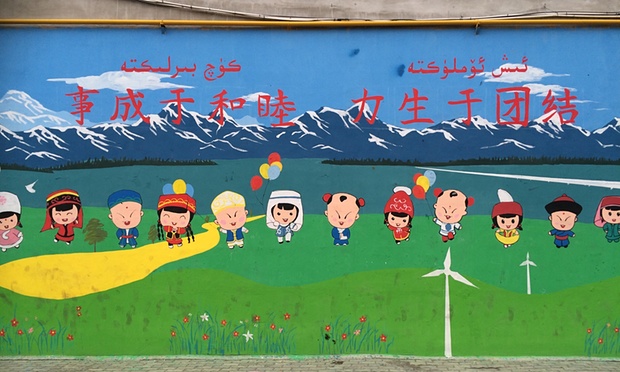
A propaganda mural in Urumqi reads: “Success comes from harmony, power comes from unity!” Photograph: Tom Phillips for the Guardian
“Is there such a thing as ethnic unity? No. Xinjiang remains a very divided society, tremendously divided, particularly among the Han and the Uighurs.”
Leibold said the immense propaganda campaign underway in Xinjiang about ethnic unity was “really about trying to convince people that there is something that doesn’t exist really on a day-to-day basis.”
“You wouldn’t need to have that message of unity if there was unity.”
Government officials in Xinjiang declined to be interviewed about the region’s 60th anniversary.
But residents, many speaking on the condition of anonymity for fear of reprisals, painted a bleak picture of how relations between Uighurs and Han Chinese migrants had soured in the wake of the 2009 riots and the attack in Urumqi last year.
“It’s not harmonious at all. It is very bad,” said one taxi driver, who asked not to be named. “On the surface people won’t say anything but everyone knows the truth. Don’t be deceived by what you see on the surface.”
“Before the attacks in 2009 the relationship was OK. But that sowed the seed of hatred,” added the driver, the son of migrants from Sichuan province. “They killed many Han Chinese people in 2009,” he claimed. “One of my friends told me they killed a pregnant woman and threw her off a bridge.”
Guo Kaixing, a 22-year-old estate agent, tried to put a brighter spin on things. “It was a very rare case,” he said of last year’s bomb attack in Urumqi. “It was an attack by people who are against integration.”
But Guo has seen Xinjiang’s troubles firsthand. In 1997, aged just four, he recalled witnessing disturbances in his hometown of Yining, a city near China’s border with Kazakhstan, which Uighurs call Ghulja. The still murky incident, which sparked a deadly crackdown, became one of the most notorious incidents in Xinjiang’s recent history.
“I saw people coming. My father threw me onto his bike and we fled,” Guo remembered. “My father said those people were very fierce.”
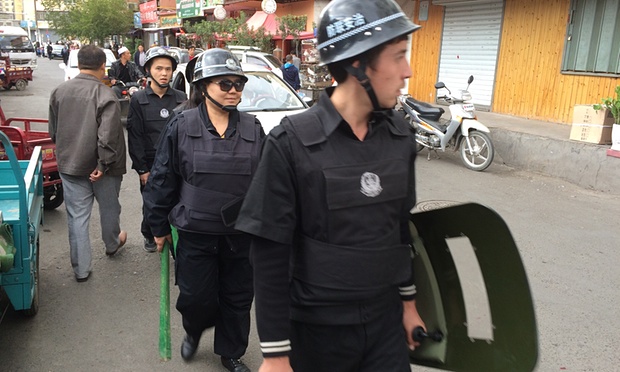
Police armed with wooden clubs patrol a Uighur neighbourhood in Urumqi. Photograph: Tom Phillips for the Guardian
In the city’s Uighur quarter, residents preferred silence.
“I’m very busy at the moment,” said a tailor who was watching over an entirely empty shop.
Another Uighur grinned from cheek to cheek as he reeled off the party line. “National unity is very important,” he said. “I’m anti-separatism.”
Leibold said draconian security restrictions meant it was impossible to gauge whether the security situation in Xinjiang was deteriorating or even improving as a result of Beijing’s crackdown and attempts to co-opt disaffected Uighurs.
By pumping huge resources into Xinjiang it was possible Beijing had achieved an uneasy short-term stability, he said.
“Xinjiang is not Chechnya. It is certainly not Syria. The question is whether that will work in the long-term … and a lot of that depends on the ability of the party to stay in power. If something were to happen in Beijing and you had a situation of political instability, well then we’d really see violence in Xinjiang on an unprecedented scale.”
Bequelin said that as Xinjiang completed 60 years, the Communist party appeared to have more control over the region than ever before.
“China has cemented its control over Xinjiang very significantly in the past decade… [but] the methods that China is employing to assimilate Xinjiang are leaving a lot of dead bodies on the ground.”
Aucun commentaire:
Enregistrer un commentaire